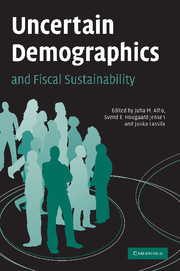Book contents
- Frontmatter
- Contents
- List of figures
- List of tables
- List of contributors
- Preface
- 1 Introduction
- Part I Uncertain demographics
- Part II Measuring sustainability in a stochastic environment
- Part III Enhancing sustainability
- Part IV Extensions
- 10 Macro-economic consequences of demographic uncertainty in world regions
- 11 Informational assumptions, aggregate mortality risk and life-cycle saving
- 12 Uncertain demographics, longevity adjustment of the retirement age and intergenerational risk-sharing
- 13 A general equilibrium analysis of annuity rates in the presence of aggregate mortality risk
- Comment: The economics of demographic uncertainty
- Index
- References
12 - Uncertain demographics, longevity adjustment of the retirement age and intergenerational risk-sharing
Published online by Cambridge University Press: 22 September 2009
- Frontmatter
- Contents
- List of figures
- List of tables
- List of contributors
- Preface
- 1 Introduction
- Part I Uncertain demographics
- Part II Measuring sustainability in a stochastic environment
- Part III Enhancing sustainability
- Part IV Extensions
- 10 Macro-economic consequences of demographic uncertainty in world regions
- 11 Informational assumptions, aggregate mortality risk and life-cycle saving
- 12 Uncertain demographics, longevity adjustment of the retirement age and intergenerational risk-sharing
- 13 A general equilibrium analysis of annuity rates in the presence of aggregate mortality risk
- Comment: The economics of demographic uncertainty
- Index
- References
Summary
Introduction
It is well known that changes in the age structure of the population can have dramatic consequences for public finances. For example, under a pay-as-you-go (PAYG) scheme, changing demographics may lead to substantial swings in either taxes or welfare services. If neither of these outcomes is politically acceptable, the issue arises as to how a welfare system can be maintained which is not only fiscally sustainable, but which also offers a fair distribution profile across different generations.
To address this challenge, several countries are now operating a medium-term fiscal strategy of public debt reduction. This should help countries avoid substantial cuts in existing welfare arrangements, yet without having to raise taxes when the projected increase in the demographic dependency ratio becomes more severe. By developing the capacity to absorb demographic changes with stable taxes, a country would not only enjoy the efficiency gains associated with tax-smoothing (Barro, 1979), but also be better protected against adverse intergenerational distribution effects.
Provided that the underlying shock – in this case a rise in the demographic dependency burden – is of a non-permanent kind, a saving (or pre-funding) strategy can be seen as a sensible way of smoothing a fiscal adjustment. Therefore, the question of whether the projected increase in the demographic dependency burden constitutes a temporary or a permanent shock is an important one.
- Type
- Chapter
- Information
- Uncertain Demographics and Fiscal Sustainability , pp. 239 - 257Publisher: Cambridge University PressPrint publication year: 2008
References
- 6
- Cited by



